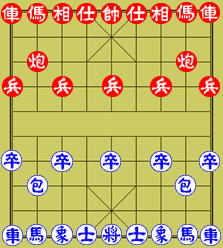 |
bookmark this page - make qweas your homepage | |
| Help Center - What's New - Newsletter - Press | ||
| Get Buttons - Link to Us - Feedback - Contact Us |
| Home | Download | Store | New Releases | Most Popular | Editor Picks | Special Prices | Rate | News | FAQ |
|
|
i-ChineseChess 1.0 - User Guide and FAQScreenshots - More DetailsBasics of Chinese ChessChinese Chess is played on a board which contains 64 squares. However, in the middle, there is a river. Also, the pieces are placed on the intersections of the lines, called points, and not in the squares, as in International Chess. Thus, Chinese Chess is played on effectively a board of 9 x 10 points, rather than on a board of 8 x 8 squares.
On each side of the board in Chinese Chess, there is a palace. Neither the king nor the guards of the kings are allowed to leave the palace. Also, the enemy kings are not allowed to "see" each other directly across the board. Like International Chess, Chinese Chess is easy to learn, but difficult to play. The basic movements of the pieces are as follows: Rook ("Ju (Che)") : The rook moves exactly like the rook in International Chess. There is no difference at all between the two. It is the only piece which moves exactly the same in both games. The rook moves in a straight line, forward, backward, or sideways. The Rook is also called a "Chariot" or a "Car" in the Chinese language. Knight ("Ma") : The Knight moves the same way as in International Chess, but with one important restriction: The Knight cannot jump. The Knight's move is a combined move of one point in any direction horizontally or vertically, plus one diagonal move. However, if the first point of the horizontal or vertical move is blocked by a piece, then the Knight may not move in that direction. The knight is called a "Horse" or a "Ma" in Chinese. Bishop ("Xiang") : For the sake of ease of memory, this piece is called the Bishop in English. It is called either the Elephant or the Minister in Chinese. It moves exactly two points diagonally, not more or less. It cannot cross the river. Thus, there are only seven points which the Bishop can ever occupy. The Bishop cannot jump. Thus, its movement is blocked if there is a piece on the intervening point. Since the Bishop cannot cross the river, its purpose is defensive in nature. Typically, one Bishop is moved so that it is two points in front of its own king, whereas the other remains on its original point. In this way, the bishops protect each other and defend their king. Guard ("Shi") : The Guard is the weakest piece. It moves only one point diagonally. This, incidentally, is exactly the way that the queen once moved in medieval chess, before it became much stronger in the fifteenth century. The Guard has one further restriction in that it cannot leave the palace. This means that there are only five points which can ever be occupied by the Guard. King ("Jiang") : The King only moves one point horizontally or vertically. Unlike the King in International Chess, the King in Chinese Chess cannot move diagonally. In addition, the King cannot leave the palace. Thus, there are only nine points which can ever be occupied by the King. Another important restriction is that the enemy kings can never oppose each other directly across an unobstructed board. Another way to say the same thing is that a King acts like a rook with respect to checking the enemy king. This becomes important in each game, where the kings try to checkmate each other. The King is called the "General" in Chinese. Pawn ("Zu or Bing") : The Pawn moves one point forward only. Unlike the Pawn in International Chess, the Pawn in Chinese Chess does not capture by moving diagonally. The Pawn in Chinese Chess captures and moves in the same way. In addition, once the Pawn crosses the river, it acquires the power to move sideways. However, the pawn can never move backwards. When it reaches the opposing back rank, the pawn cannot promote. Instead, it can only move sideways. Cannon ("Pao") : The Cannon is a unique piece and the most difficult to learn piece from the Western point of view. The Cannon moves like a rook, but it captures by jumping. In order to capture an enemy piece, the Cannon must jump over another piece in between. This intervening piece is known as the "Gun Mount" in Chinese. Finally, unlike in International Chess, stalemate is not a draw in Chinese Chess. Rather, stalemate is a win for the side who has stalemated the other. Screenshots - More Details |
|
Search -
Download -
Store -
Directory -
Service -
Developer Center
© 2006 Qweas Home - Privacy Policy - Terms of Use - Site Map - About Qweas |

